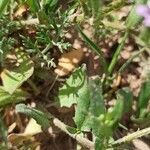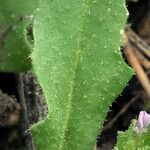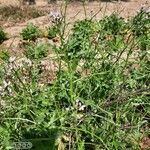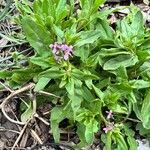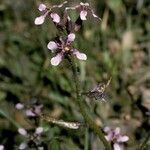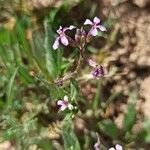Plants papillose, sometimes pubescent, papillae sometimes mixed with simple trichomes. Stems (0.5-)1-4(-5.6) dm. Basal leaves (often withered by flowering); petiole (0.5-)1-2(-4) cm; blade oblanceolate or oblong, (1.5-)2.5-8(-13) cm × (4-)8-20(-30) mm, base cuneate or attenuate, apex acute, surfaces glandular. Cauline leaves similar to basal, distalmost subsessile, blades smaller distally. Fruiting pedicels (2-)3-5 mm, glandular. Flowers: sepals purplish, (3-) 4-5(-6) × 0.5-0.7 mm; petals 8-10(-12) × 1-2 mm, claw 6-7 mm; filaments 4-6(-7) mm; anthers ca. 1.5 mm. Fruits slightly curved-ascending, (1.4-)1.8-2.5(-3) cm × 1.5-2 mm, with 8-12 constrictions on each side; style (6-)10-18(-22) mm. Seeds brown, 1-1.4 × 0.8-1 mm. 2n = 14.
Widely branched annual 2–4 dm; stem, axis of the infl, and pedicels sparsely beset with stipitate glands; lvs lanceolate to oblanceolate, 3–8 cm, with a few low teeth; sep 7 mm; pet blue-purple, ca 12 mm; pedicels 2–5 mm; frs ascending, the body 2–3 cm, the beak 1–2 cm; 2n=14. Native of c. Asia, established as a weed in w. U.S. and occasionally adventive in our range. May–July. Malcolmia maritima R. Br., an Old World sp. habitally similar to C. tenella, but eglandular and without the cross-partitions in the scarcely beaked fr, is adventive on L.I.
A cabbage family herb. It is an annual plant up to 40 cm tall. It is hairy. The leaves at the base and on the lower stem are broadly oval with lobes along the side. They are 3-4 cm long by 3-5 mm wide. The leaves in the stems do not have leaf stalks. They have teeth. The flowers are lavender and small. They are 3 mm long. The pods are cylinder shaped and 3-5 cm long and slightly curved. They have a beak. The seeds are oblong and 1.5 mm long. They are light brown.
